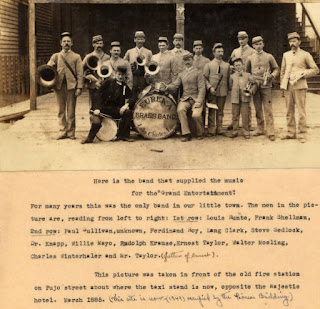NOLA History: The Brass Bands of New Orleans
This article from Edward Branley, a writer for the New Orleans tourism bureau website, serves as a good entry point into some of the basic history of New Orleans' brass bands. I like to call this a 30,000 foot view since it throws out several points but doesn't go into very much depth.
Branley address the belief that street band music in the 1880's rose out of the need for music at events such as funerals or weddings being combined with the instruments that remained from the Civil War era brass bands. That music eventually began to fuse with early elements of jazz within the bars and brothers of Storyville.
In part one of a three part series on "modern" brass bands in the late 1980's Kalamu Ya Salaam writes more in depth on the topic of the early origins of the style. One thing he discusses that I had not though of before was how popular polka bands were in the New Orleans during the late nineteenth century. He asserts the the brass band movement was the combination of polka, parade bands, and early jazz music. I'm also interested in his discussion of how the brass band movement was an essential part of early jazz music with artists such as "King" Oliver and Louis armstrong making their way in brass bands before playing more traditional jazz music.
For what it's worth Off Beat Magazine, the publication this article comes from is focused on the native music of Louisiana, which shades the discussion of brass band music being from unique to New Orleans. In the passage below Salaam writes beautifully about what less tangible elements lead to the prevalence of this form of music in New Orleans.
Although it might seem obvious that brass band music would naturally develop in New Orleans because of its cultural richness, the fact is that the jazz band was not simply an extension of existing American popular musical activity, but rather the traditional New Orleans marching jazz band was a radical synthesis and transformation that combined both traditional African cultural antecedents with the technical demands of existing European musical cultural expressions to produce a music that is profoundly American in the truest and most accurate sense of what American musical culture is and aspires to be.Eureka Brass Band (1885)
 |
| McNeese State University |
Despite the lack of sousaphone and the "whiteness" of the group I like how this photo demonstrates the community nature of early and even present brass bands. You can see the inclusion of young children in the group as well as the inconsistencies in the uniforms indicating this was likely not a professional ensemble. The caption reads:
Here is the band that supplied the music for the 'Grand Entertainment.' For many years this was the only band in our little town. The men in the picture are, readingfrom left to right: 1st row: Louis Runte, Frank Shellman. 2nd row: Paul Sullivan, unknown, Ferdinand Roy, Lang Clark, Steve Sedlock, Dr. Knapp, Willie Mayo, Rudolph Krause, Ernest Taylor, Walter Moeling, Charles Winterhaler and Mr. Taylor (father of Ernest). This picture was taken in front of the old fire station on Pujo street about where the taxi stand is now, opposite the Majestic hotel. March 1885. (This site is now (1949) occupied by the Pioneer Building.)I really like how this photo paints a different picture than I expected to find in early New Orleans brass bands. I hope to continue to use these posts as a venue for my discoveries regarding the origins of the genre.
No comments:
Post a Comment